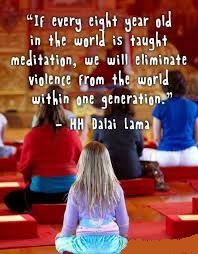by Jennifer Chait,
We’ve seen yoga, standing desks and vegetarian lunches turn troubled schools around, but we’ve never seen meditation adopted successfully within the school system. Until now. According to reports, several San Francisco middle and high schools, as well as scattered schools around the Bay Area, have adopted what they call, “Quiet Time” – a stress-reduction meditation strategy that is doing wonders for students and teachers.
The first school to adopt the Quiet Time practice in 2007, Visitacion Valley Middle School, has reaped huge rewards. Formally a school largely out of control, Visitacion Valley is smack in the middle of a neighborhood where shootings are common. This resulted in the students getting bad grades, skipping school and fighting daily, as they were likely highly troubled by the violence surrounding them. The situation at Visitacion Valley was so dire that teachers even started calling in sick, to avoid teaching these kids.The school tried everything from counseling to peer support to after-school tutoring and sports but nothing seemed to work until Quiet Time entered the picture.
The SFGate reports that within the first year that Quiet Time was used, “The number of suspensions fell by 45 percent. Within four years, the suspension rate was among the lowest in the city. Daily attendance rates climbed to 98 percent, well above the citywide average. Grade point averages improved markedly.” Most importantly, the SFGate reports that, “Remarkably, in the annual California Healthy Kids Survey, these middle school youngsters recorded the highest happiness levels in San Francisco.” Now, at least three other schools have adopted Quiet Time with similarly successful results.
Burton High School notes that students involved in Quiet Time say they experience significantly less stress and depression, and greater self-esteem, plus academic successes have risen dramatically. The California Achievement Test, which measures grades of kids in CA, found that twice as many students in Quiet Time schools have become proficient in English, when compared to students who don’t participate in Quiet Time, and the gap is even bigger in math. Teachers in the schools using Quiet Time are also faring better, stating that they’re, “Less emotionally exhausted and more resilient.” The Quiet Time website notes the following success rates of meditation in schools:
- 10% improvement in test scores—and a narrowing of the achievement gap.
- Highly effective for increasing creativity.
- Improved teacher retention and reduced teacher burnout.
- Greater happiness, focus and self-confidence.
- Reduced ADHD symptoms and symptoms of other learning disorders.
- 86% reduction in suspensions over two years.
- 40% reduction in psychological distress, including stress, anxiety and depression.
- 65% decrease in violent conflict over two years.
While of course, we can’t know (yet) the very long-term effects of meditation in schools, it’s clear that schools are benefiting from the innovative practice, making Quiet Time a stellar idea for other schools to try.
For more information on the Quiet Time Program, contact Jamie@DavidLynchFoundation.org.
Source: http://www.inhabitots.com/schools-in-san-francisco-implement-meditation-time-students-happiness-and-academic-success-soars/








